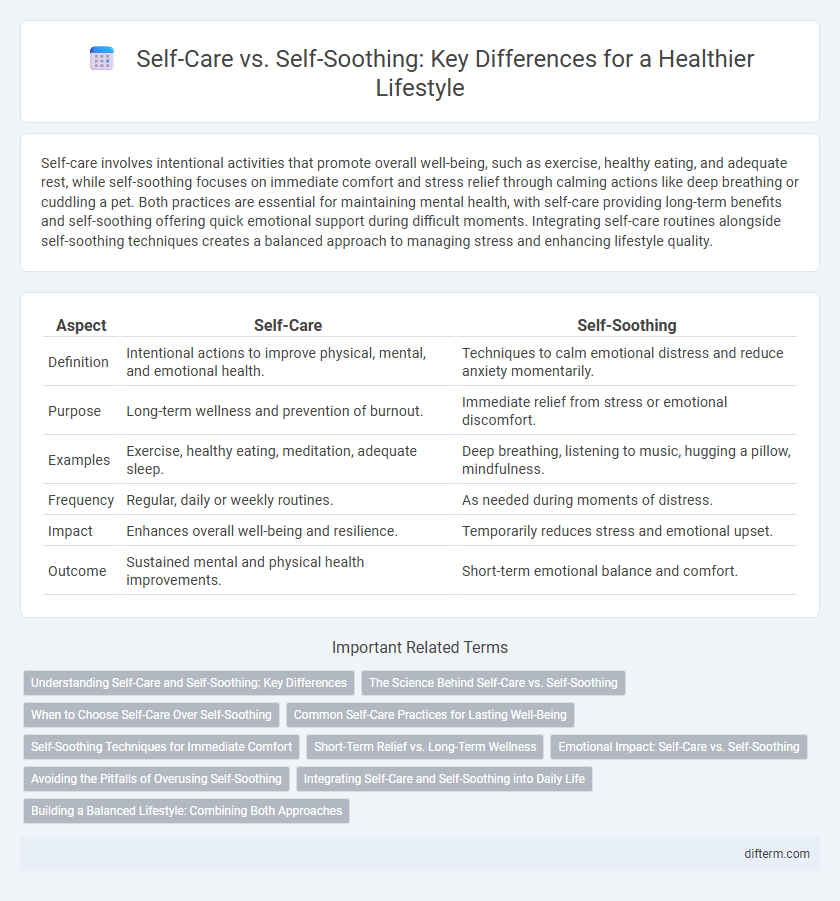Self-care involves intentional activities that promote overall well-being, such as exercise, healthy eating, and adequate rest, while self-soothing focuses on immediate comfort and stress relief through calming actions like deep breathing or cuddling a pet. Both practices are essential for maintaining mental health, with self-care providing long-term benefits and self-soothing offering quick emotional support during difficult moments. Integrating self-care routines alongside self-soothing techniques creates a balanced approach to managing stress and enhancing lifestyle quality.
Table of Comparison
| Aspect | Self-Care | Self-Soothing |
|---|---|---|
| Definition | Intentional actions to improve physical, mental, and emotional health. | Techniques to calm emotional distress and reduce anxiety momentarily. |
| Purpose | Long-term wellness and prevention of burnout. | Immediate relief from stress or emotional discomfort. |
| Examples | Exercise, healthy eating, meditation, adequate sleep. | Deep breathing, listening to music, hugging a pillow, mindfulness. |
| Frequency | Regular, daily or weekly routines. | As needed during moments of distress. |
| Impact | Enhances overall well-being and resilience. | Temporarily reduces stress and emotional upset. |
| Outcome | Sustained mental and physical health improvements. | Short-term emotional balance and comfort. |
Understanding Self-Care and Self-Soothing: Key Differences
Self-care involves proactive practices that promote overall well-being, such as regular exercise, healthy eating, and adequate sleep, while self-soothing focuses on immediate emotional relief through techniques like deep breathing, meditation, or sensory comforts. Understanding the key differences between these concepts helps individuals develop sustainable habits that support both mental and physical health. Integrating consistent self-care routines enhances resilience, whereas effective self-soothing strategies manage stress and emotional discomfort in the moment.
The Science Behind Self-Care vs. Self-Soothing
Self-care involves deliberate practices that promote long-term mental and physical well-being by addressing underlying needs, while self-soothing primarily targets immediate emotional relief through comfort-focused activities. Neuroscientific research highlights that self-care activates the parasympathetic nervous system, fostering resilience and stress regulation, whereas self-soothing often engages transient dopamine release for short-lived comfort. Understanding these mechanisms empowers individuals to implement sustainable strategies that enhance overall health rather than temporary emotional coping.
When to Choose Self-Care Over Self-Soothing
Choosing self-care over self-soothing is essential when addressing long-term well-being and emotional resilience. Self-care involves proactive activities like regular exercise, balanced nutrition, and setting healthy boundaries that promote sustained mental and physical health. Self-soothing, while helpful for immediate stress relief, should be reserved for moments requiring temporary comfort rather than ongoing emotional support.
Common Self-Care Practices for Lasting Well-Being
Common self-care practices for lasting well-being include maintaining a balanced diet, regular physical activity, and sufficient sleep to support overall health. Effective stress management techniques such as mindfulness meditation and journaling promote emotional resilience and prevent burnout. Prioritizing hydration, setting boundaries, and engaging in hobbies enrich daily life and nurture sustained mental and physical vitality.
Self-Soothing Techniques for Immediate Comfort
Self-soothing techniques provide immediate comfort by engaging the senses through practices like deep breathing, progressive muscle relaxation, or sensory stimulation with soothing objects such as stress balls or weighted blankets. These methods help regulate emotional distress and reduce anxiety quickly by activating the parasympathetic nervous system. Implementing self-soothing strategies during moments of acute stress enhances emotional resilience and fosters a sense of calm without relying on external distractions.
Short-Term Relief vs. Long-Term Wellness
Self-care involves intentional practices that promote long-term wellness, such as regular exercise, balanced nutrition, and mindfulness meditation, supporting sustained physical and mental health. Self-soothing techniques provide short-term relief from stress or emotional discomfort through activities like deep breathing, listening to music, or using comfort objects, which may not address underlying issues. Prioritizing self-care over self-soothing fosters resilience and helps prevent chronic stress, enhancing overall quality of life and emotional stability.
Emotional Impact: Self-Care vs. Self-Soothing
Self-care involves intentional actions that promote long-term emotional well-being, such as regular exercise, healthy eating, and mindfulness practices, which foster resilience and reduce stress. Self-soothing typically provides immediate, temporary relief from emotional distress through activities like binge-watching TV or comfort eating, often lacking a sustainable positive impact. Understanding the emotional impact highlights that self-care builds emotional strength, while self-soothing may mask underlying issues without addressing root causes.
Avoiding the Pitfalls of Overusing Self-Soothing
Overreliance on self-soothing techniques, such as binge-watching or emotional eating, can mask underlying issues without addressing root causes, leading to emotional stagnation. Effective self-care incorporates intentional practices like mindfulness, exercise, and balanced nutrition that promote long-term well-being and resilience. Recognizing the difference allows individuals to develop healthier coping strategies that sustain mental and physical health over time.
Integrating Self-Care and Self-Soothing into Daily Life
Integrating self-care and self-soothing into daily life enhances emotional resilience and overall well-being by balancing proactive health habits with immediate stress relief techniques. Effective self-care routines include regular exercise, balanced nutrition, and sufficient sleep, while self-soothing practices such as deep breathing, mindfulness meditation, and sensory activities provide instant calm during stressful moments. Consistent application of both strategies fosters sustained mental health and empowers individuals to navigate daily challenges with greater ease.
Building a Balanced Lifestyle: Combining Both Approaches
Building a balanced lifestyle involves integrating self-care routines, such as exercise and nutritious meals, with self-soothing techniques like deep breathing and mindfulness to manage stress effectively. Prioritizing both physical health and emotional well-being creates resilience and sustained mental clarity. This holistic approach ensures long-term personal growth and improved overall quality of life.
self-care vs self-soothing Infographic

 difterm.com
difterm.com